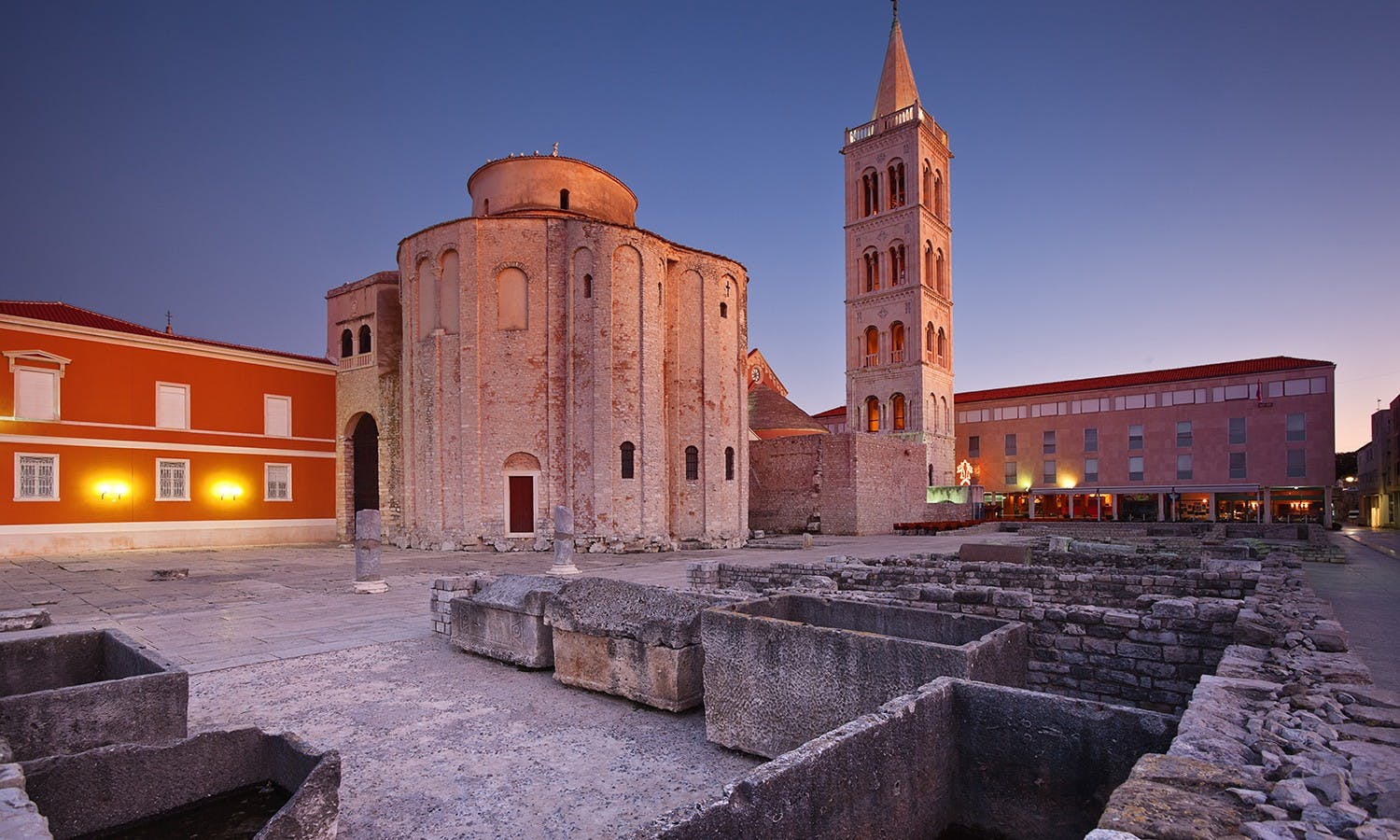-
-
USD - United States (US) dollar
- EUR - Euro
- GBP - Pound sterling
- CAD - Canadian dollar
- AUD - Australian dollar
- SGD - Singapore dollar
- AED - United Arab Emirates dirham
- BRL - Brazilian real
- ARS - Argentine peso
- MXN - Mexican peso
- COP - Colombian peso
- SAR - Saudi riyal
- OMR - Omani rial
- KWD - Kuwaiti dinar
- JOD - Jordanian dinar
- EGP - Egyptian pound
- INR - Indian rupee
- RUB - Russian ruble
- DKK - Danish krone
- NZD - New Zealand dollar
- HKD - Hong Kong dollar
- CLP - Chilean peso
- QAR - Qatari riyal
- BHD - Bahraini dinar
- ILS - Israeli new shekel
- MYR - Malaysian ringgit
- UAH - Ukrainian hryvnia
- KZT - Kazakhstani tenge
- RON - Romanian leu
- SEK - Swedish krona
-
USD - United States (US) dollar
- Cart
- FAQ
- Login

Zadar walking tour: Sea Organ and Roman Forum
Validity:
Flexible
Do this because
- Listen to the famous Sea Organ
- Visit the Franciscan monestary museum
- Stroll the ancient Roman Forum
- See the world's third largest religious art collection
What to expect
Discover the historically rich and architecturallystunning city of Zadar - the capital Dalmatia, during your walking tour with expert local guide, learning life in Zadar and discovering its mysteries through 2000 years of history.
Zadar is a perfect example of how cultural heritage of the past can be combined with modern achievements and ideas.
Your tour begins in the Park of the Greats, a beautiful calm park with statues of famous Zadar inhabitants where your local expert guide will give you an overview of Zadar's history.
The first big attraction is the Greeting to the Sun a modern light installation comprised of three hundred multi-layered glass plates in the shape of a 22-meter diameter circle atop the stone-paved waterfront.
Situated beside the Greeting to the Sun is the world famous Sea Organ, comprised of 35 pipes of different length that that sit at the lowest tide level. All differing in length and diameter, the tilts were built vertically in to the coast and they rise up to the paved part of the shore at a slant, ending in a canal. The LABIUMS (whistles) on the pipes play 7 chords of 5 tones, and above the canal, there are perforated stone stairs through which the sound comes out, the air pushed by the sea. This site is a blend of human ideas and skills, and the energy of the sea, waves, tide and flood make a perfect place for relaxation, contemplation and conversation, while listening to an endless concert of mystic harmonies of the "Orchestra of Nature".
From modern wonders, you will travel back to medieval times by visting the Gothic-style church of Saint Francis and the Franciscan monestary, Dalmatia's oldest church dating back to 1283. It represents a type of so called Gothic monastic church characterized by a single nave with a raised shrine. The sacristy, which follows the choir stalls, holds an important place in Croatian history as the Venetian Republic and Hungarian-Croatian king Ludovik An?uvinac made peace inside it, an act by which the Venetians gave up their pretensions to Dalmatia. In a decorated treasury next to the sacristy, there are collected works of art with a great number of exhibits of which the most valuable is a 12th-century painting of the crucifixion. South from the church, there is also a Renaissance cloister built in 1556 with a rich library.
Your visit to medieval times continues by visiting the cathedral of Saint Anastasia - Dalmatia's largest cathedral. Its oldest parts were an early Christian basilica, but its present Romanesque appearance dates back to the 12th century. During the crusaders´ siege and conquest in 1202, the Cathedral was damaged, but was reconstructed and expanded. You can take a walk inside to see the marble sarcophagus containing relics of Saint Anastasia inscribed by Bishop Donat.
Your tour will take you even further back in time as you arrive at the ancient Roman colony Julia Iader, where you will see the Roman Forum, the center of life in the Roman colony, complete with the original 2000-year-old sidewalk as well as many other Roman architecture remains. Located on the foundations of the Forum is the church of Saint Donat, a fine example of early Romanesque architecture. and the Archbishop's Palace. Round in shape and known for its acoustics, Saint Donat is a symbol of Zadar and marked by its exemplary combination of space and sound.
The municipal Roman-era square was built between the 1st century BC and the 3rd century AD, and is 45 by 90 metres in size, representing a highly developed example of the forum complex, and it is one of the most important among the ancient Adriatic cities.
Next you will visit the world's third largest collection of religious art called The Gold and Silver of Zadar, a priceless treasure preserved by Benedictine nuns throughout the years. Some valuable exhibit items (lace, church fabrics embroidered with golden threads) were produced by the nuns' hands.
Continue to explore Zadar's narrow streets studded with gothic houses as your guide shares fascinating stories, including that of Maraschino, the famous Zadar liqueur enjoyed by many historical carachters. You will also get the chance to taste some and buy a bottle.
Next, see the "Zadar" Land Gate built by Venetian architect Michele Sanmicheli in 1543, one of Dalmatia's finest Renaissance monuments. The triumphal arch features a central passage for wheeled traffic and two smaller side arches for pedestrians. It is decorated with motifs such as St. Chrysogonus (Zadar’s main patron saint) on his horse, and the Shield of St. Mark (the coat of arms of the Republic of Venice).
Your journey through Zadar's history continues with a visit to the Five Wells Square, located on a site between the medieval City Walls and the Renaissance bastion Grimani, home to Croatia's oldest park. The Square features exactly what its name suggests – five wells lined up in a row. Fromhere, you will enter in Queen Jelena Madije Park, Croatia's first public park founded by Austrian commander Baron Franz Ludwig von Welden in 1829, a passionate botanist and admirer of Dalmatian flora.
The People's Square has been the center of public life in Zadar since the Renaissance. Platea magna, the foundations of municipal institutions, were laid onsite in the early Middle Ages.
Zadar has always accepted people from its hinterland and islands, and because of this, is rich with various gastronomic pleasures. You will finish your tour by visiting the city market and taste its products.
We hope by visiting this special city you will desire to come back and give your soul and your senses another trip to paradise.
Read more
from:
$ 79











